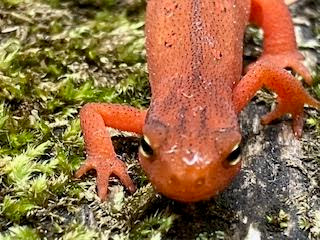Guest post by Nic Cormier, Education Intern
Until last week the garden bordering the lawn had not been worked in almost five years. A few previously planted perennials managed to keep a foothold among the abundant “weeds”. Additional native flowers, sometimes considered weeds, were also uncovered. We plan to open it back up and bring some order to the garden once more. The goal is to make a garden that attracts birds and butterflies, using primarily native plants. We want this to be an educational tool for visitors as well, who will see what we have done/are doing and hopefully feel inspired and empowered to do something similar in their backyard.
Last week we took some time and cleaned out plants that we didn’t want in a ten foot by five foot section. We left the plants we liked and knew were beneficial to wildlife. Interspersed within these we planted Marigolds, Astilbe, Bleeding Heart, Foxglove, Snapdragons, Cosmos, Dwarf Spirea, Salvia spp. and Black-eyed Susan. We also released a Coneflower, Black-eyed Susan, Sweet William, Mystery Plant (see picture) and Hemp Nettle. The plants that we put in (minus the Black-eyed Susan) were all donated from Pleasant Mount Farm. (Thank you Heidi!)
We also drew up plans for future gardens, and now we are looking for some plants that may be donated or sold at discount. (The Museum is a 501 (c) (3) non-profit organization, for contact info see www.birdsofvermont.org)
Here is a list of what were looking for:
Chokeberry- Aronia ssp.
Spicebush- Lindera benzoin
Columbine- Aquilegia ssp.
Butterfly Bush- Buddleia ssp.
Swamp Milkweed- Asclepias incarnata
Turtlehead- Chelone glabra
Fireweed- Epilobium angustifolium
Cardinal Flower- Lobelia cardinalis
Bee Balm – Monarda ssp.
We would greatly appreciate any and all donations and/or inquiries into places where we could get them. As stated before we are trying to make the garden as native as we can but we will not say no to non-native species, unless they are invasive.
Below is our mystery plant. Do you know what it is?











